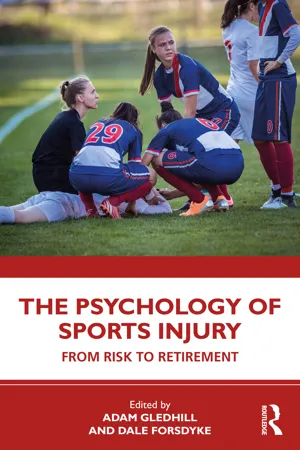
The Psychology of Sports Injury
From Risk to Retirement
- 248 pages
- English
- ePUB (mobile friendly)
- Available on iOS & Android
The Psychology of Sports Injury
From Risk to Retirement
About this book
The Psychology of Sports Injury: From Risk to Retirement provides a critical overview of the psychology of sports injury, covering the 5Rs of sports injury: risk, response, rehabilitation, return to sport and retirement.
Drawing on a range of expert international perspectives from the fields of sport psychology and sport and exercise medicine, The Psychology of Sports Injury covers the psychological considerations associated with sports injuries, prior to the onset of injury through to supporting athletes with post-injury retirement. In addition to this injury lifespan perspective, the book features special interest topics including anterior cruciate ligament injury, sport-related concussion, spinal cord injury and the role of coaches in achieving athlete and team medical outcomes. Additionally, case studies provide the opportunity to apply learning from each chapter.
By covering the sports injury journey from risk factors to retirement and including athlete mental health during sports injury, The Psychology of Sports Injury is an essential text for students, instructors, and practitioners in sports psychology, sport and exercise medicine and other related fields.
Frequently asked questions
- Essential is ideal for learners and professionals who enjoy exploring a wide range of subjects. Access the Essential Library with 800,000+ trusted titles and best-sellers across business, personal growth, and the humanities. Includes unlimited reading time and Standard Read Aloud voice.
- Complete: Perfect for advanced learners and researchers needing full, unrestricted access. Unlock 1.4M+ books across hundreds of subjects, including academic and specialized titles. The Complete Plan also includes advanced features like Premium Read Aloud and Research Assistant.
Please note we cannot support devices running on iOS 13 and Android 7 or earlier. Learn more about using the app.
Information
Part I THE ROLE OF PSYCHOLOGY IN SPORTS INJURY RISK AND INJURY RISK REDUCTION
References
- Appaneal, R. & Perna, F. (2014). Biopsychosocial model of injury. In R. Eklund & G. Tenenbaum (Eds.), Encyclopedia of sport and exercise psychology (pp. 74–76). Thousand Oaks: SAGE Publications.
- Eliakim, E., Morgulev, E., Lidor, R., & Meckel, Y. (2020). Estimation of injury costs: Financial damage of English Premier League teams’ underachievement due to injuries. BMJ Open Sport & Exercise Medicine. DOI: 10.1136/bmjsem-2019-000675.
- Gledhill, A., & Forsdyke, D. (2018). An ounce of prevention is better than a pound of cure: Shouldn’t we be doing EVERYTHING to reduce sports injury incidence and burden? British Journal of Sports Medicine, 52, 1292–1293.
- Gledhill, A., Forsdyke, D., & Murray, E. (2018). Psychological interventions used to reduce sports injuries: A systematic review of real-world effectiveness. British Journal of Sports Medicine, 52, 967–971.
- Hägglund, M., Waldén, M., Magnusson, H., Kristenson, K., Bengtsson, H., & Ekstrand, J. (2013). Injuries affect team performance negatively in professional football: An 11-year follow-up of the UEFA Champions League injury study British Journal of Sports Medicine, 47, 738–742.
- Ivarsson, A., Johnson, U., Andersen, M. B., Tranaeus, U., Stenling, A., & Lindwall, M. (2017). Psychosocial factors and sports injuries: Meta-analyses for prediction and prevention. Sports Medicine, 47, 353–365.
- Putukian, M. (2016). The psychological response to injury in student athletes: A narrative review with a focus on mental health. British Journal of Sports Medicine, 50, 145–148.
- Ristolainen, L., Ketunen, J. K., Kujala, U. M., & Heinonen, A. (2012). Sports injuries as the main cause of sports career termination among Finnish top-level athletes. European Journal of Sport Science, 12, 274–282.
- Williams, J., & Andersen, M. (1998) Psychosocial antecedents of sport injury: Review and critique of the stress and injury model. Journal of Applied Sport Psychology, 10(1), 5–25.
1THE INJURY-PRONE ATHLETE
PSYCHOSOCIAL RISK FACTORS IN SPORTS INJURY
INTRODUCTION
THE MODEL OF STRESS AND ATHLETIC INJURY
Table of contents
- Cover
- Half Title
- Title Page
- Copyright Page
- Dedication
- Table of Contents
- Foreword
- Preface
- Acknowledgements
- Contributors
- Part I: The role of psychology in sports injury risk and injury risk reduction
- Part II: Psychological responses to sports injury
- Part III: Enhancing sports injury rehabilitation experiences for injured athletes
- Part IV: The psychology of return to sport decisions
- Part V: Special interests in sports injury
- Index